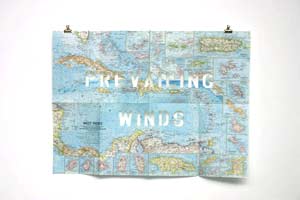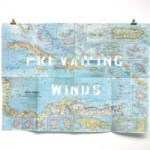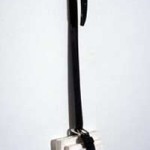In his statement, curator Jason Kalogiros reminds us that "[a]s firmly rooted in a present moment or place as someone or something is, they always carry with them the residue of the past as well as a relationship to a time that has not yet arrived." The artists in "We Are Where We Are Not" have each approached the concepts of identity construction and personal history, with mixed and sometimes confusing results.
Kalogiros has included his own work in the show, which is often the case with guest curators at GASP. Far from problematic, this way of organizing an exhibition seems quite fitting for the venue, and allows an artist to find others with similar interests and create a show around those themes. His piece, "Inheritance", features a set of cast books held by a belt, as if they might be carried to school by a student. The fact that the books are cast, however, and the bland whiteness of their being sculpture, call attention to the leather belt, and imply other uses for that strap. The title calls to mind a parent or parents, and coupled with the strong belt image it is easy to imagine punishment, perhaps abuse, at the hands of an adult. The near-presence of the books hints at a response, a desire for knowledge to escape the belt, or a mind trapped within its boundaries.
In many ways, Andrew Tosiello's drawings hint at the same unspoken family histories as Kalogiros. HIs "Twenty-Five Silhouette Portraits of Italian-American Mobsters" borders on the self-explanatory. Whether or not a viewer can decipher the silhouette portrait and identify an authentic mobster, the implication is that all mobsters are Italian-American. Tosiello forces us to consider that identifying with that ancestry means accepting or denying a relationship to the Mob, including all that is unfair about that assumption.
Far more oblique are the cut-paper works of Gabrielle Teschner. Her maps, cut with stencils to reveal words, seem at first to avoid speaking about identity. Yet, when considering pieces such as "Prevailing Winds", it becomes necessary to relate the notion of wind to the islands of the map, and then to realize that our very notions of site and history are often created for us by outside influences. The labeling of sites with their implied, or perhaps artificial, evokations leaves us gasping for any sense of our own personal experience.
Each artist in "We Are Where We Are Not" claims to be exploring their personal history and identity. Some, however, feel impenetrable or awkward. Jack Schneider's images, full of pop references, fail to offer any insight. By relying on representations of commercial products and their relationship to personal history, we are left to ponder how our personal histories are shaped by mass-produced objects. This, thematically, could be very strong; however, without guidance the viewer is left with an idea but no implication of how the artist wants us to pursue it.
The show is rounded out by a long list of artists: Edward Lee, Taha Belal, Jack Schneider, Sam Moyer, Kenneth Jones, Luke Butler, Michelle Blade, Rebecca Ebeling, and Breck Brunson.
Overall, "We Are Where We Are Not" is a strong show, full of thoughtful work. The prevailing theme succeeds in tying the work together, and offers a point of entry for reading and digesting the individual works. While some editing might have improved this show, the overall result is very powerful and worth a visit.
- Gabrielle Teschner “Prevailing Winds”
- Jason Kalogiros “Inheritance”
- Andrew Tosiello “Twenty-Five Silhouette Portraits of Italian-American Mobsters”
Links:
Gallery Artists Studio Projects (GASP)
"we are where we are not" is on view February 9 - March 23, 2007 at GASP.
All images are courtesy of the artist and GASP.







